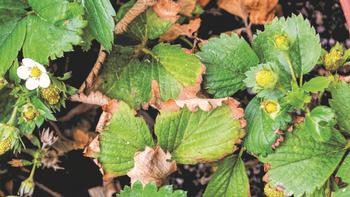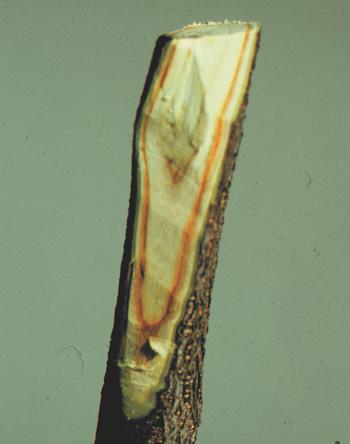What to do about Verticillium Wilt
-
Wendy Irving
-
Oh no! What’s wrong with my tomato plant, my strawberries, the Japanese maple? It could be Verticillium wilt, a disease caused by a soil-borne fungus that can affect a wide variety of herbaceous and woody plants and trees.
 Tell-tale signs of Verticillium wilt on a strawberry plant. Photo: Alamy Stock Photo
Tell-tale signs of Verticillium wilt on a strawberry plant. Photo: Alamy Stock PhotoThis fungus enters through the roots and disrupts the plant’s vascular system, particularly the xylem, which moves water from the roots to the leaves. Early symptoms are the yellowing of leaves with browning around the edges, and the wilting of shoots tips, mimicking a lack of water. With a larger plant or tree, one part or all of it may have leaves that turn yellow to brown but don’t drop for months. The disease may develop during a cool, wet spring but might not show up until the weather is warm and the plant is under stress, which can happen more now with the drought conditions. If you are sure your plant is getting enough water and still looks parched, examine its lower parts since the disease starts from the roots. Peel back the skin or bark on a lower stem, branch, or trunk and look for streaky discoloration or dark staining along the vascular tissue.
In the vegetable garden, plants such as tomatoes, strawberries, potatoes, peppers, eggplant, and various melons are susceptible to Verticillium wilt. Luckily, scientists continued to develop vegetable varieties resistant to Verticillium wilt. When shopping for, let’s say, new tomato plants or seeds, look for a “V” on the label indicating that the plant is resistant to the disease (chances are it will be labeled as being resistant to a number of other diseases as well, particularly, Fusarium (“F”), a similar disease). Good news regarding strawberries ? in 2019, the UC Davis Strawberry Breeding Program introduced five new varieties of disease-resistant berries − Moxie, Royal, Royce, Valiant, Victor, and Warrior. The linear discoloration of the xylem under the bark of this branch indicates Verticillium wilt. Photo: University of Wisconsin Horticulture
The linear discoloration of the xylem under the bark of this branch indicates Verticillium wilt. Photo: University of Wisconsin HorticultureFruit and nut trees, such as olive, avocado, almond, cherry, peach, plum, pecan, and persimmon, and many favorite ornamentals, such as maple, magnolia, pepper, and Chinese pistache, are vulnerable to Verticillium wilt. An infected tree will probably die, but there’s a chance it will survive if given the proper care (good sanitation practices, pruning, regular watering with good drainage, low nitrogen/high phosphorus fertilizer). Still, it might be a better idea to replace it with an immune or resistant tree. Among those trees are birch, oak, holly, walnut, pear, and most citrus.
Verticillium fungus is ubiquitous, so infection prevention is the key. What to do? Most obviously, use resistant plants and sound cultural practices, as mentioned above. In the vegetable garden, areas that have had the disease can be treated with solarization and soil amendments. Or allow the area to rest, or plant it with something that is immune for a few seasons. Rotate plants. Don’t plant the same tomato year after year in the same spot or replace it with another disease-prone plant. Try not to damage root systems when weeding and doing regular maintenance. If removing infected plants, dig them up by the roots, and dispose of them properly. The same goes for branches and leaves removed in and around infected trees and shrubs—thoroughly clean tools used for these chores. Infected materials shouldn’t go in your home compost pile for obvious reasons. If you live in an area with a state-permitted composting facility (Redwood Landfill’s WM EarthCare of Marin in Novato, for example), it should be safe to put in your green bin for pickup. An easy way to avoid soil-invading fungi is to try raised bed and container gardening, replacing or amending the soil each season.


